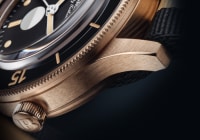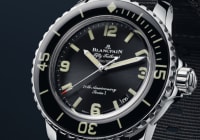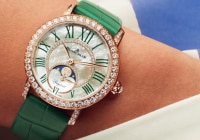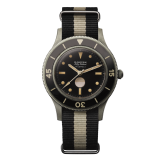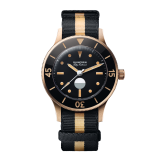
Search in Issues
Chapters
List of parts
Chapter 2
Fifty Fathoms 70th Anniversary ACT 3
The US Navy’s Blancpain MIL-SPEC provides the inspiration for the third new 70th Anniversary Fifty Fathoms.
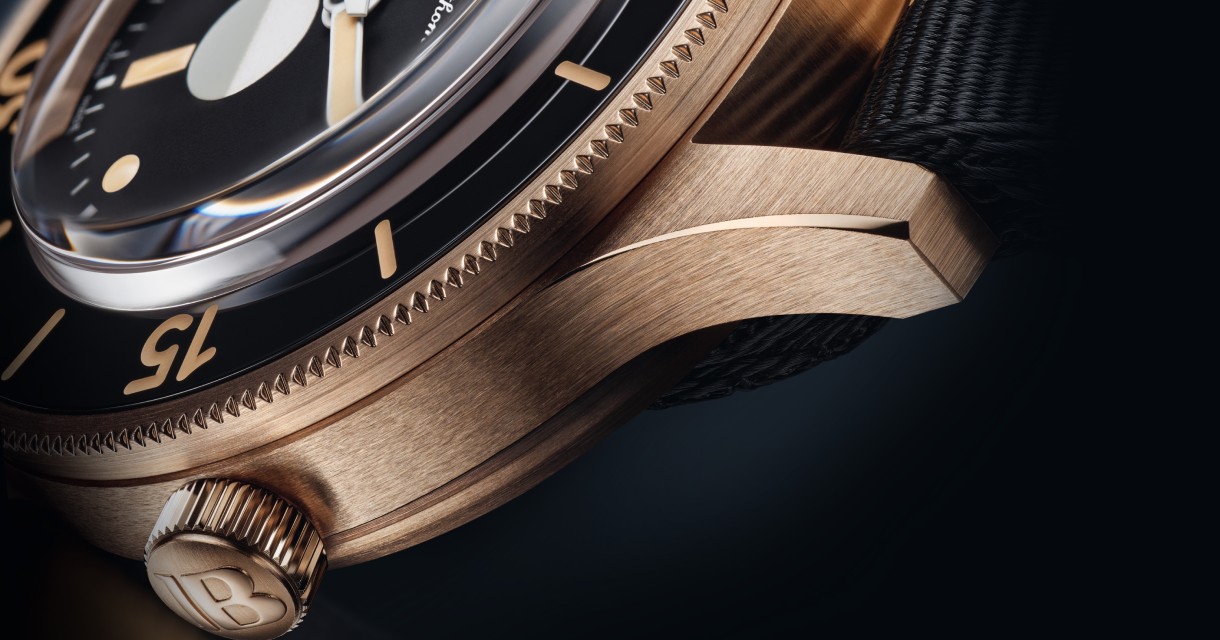
Perhaps the RAREST OF VINTAGE FIFTY FATHOMS models was the MIL-SPEC created for the US Navy.
Which Fifty Fathoms model can lay claim to being the “unicorn”? The hardest to find today? The three decades of the vintage Fifty Fathoms witnessed many declinations in both civilian and military models. Without doubt, though, the rarest of them all was a version of the MIL-SPEC created for the United States Navy. The saga of how the United States came to choose Blancpain for its divers reveals the reason for its rarity today and illuminates the reinterpretation for the new limited edition Fifty Fathoms 70th Anniversary Act 3.
Military procurement seldom occurs swiftly and the Navy’s selection process for its dive watch was no exception, spanning the period 1955 through 1959. The process began with the publication of a draft specification for what the Navy termed a “Submersible Wrist Watch”. The specification bristled with details: composition of the steel, radiation levels (yes, the Navy required the use of radioactive materials for luminance), crystal strength (dropping a steel ball from a 40” height onto the crystal), bezel robustness (hitting the bezel with a hammer to ensure the integrity of the ring), pressure testing, isochronism performance, number of jewels in the movement, details of the dial and hands, inclusion of a moisture indicator on the dial, and MUCH more. The specification was fifteen pages in length, most pages arranged with double columns of text in a small font setting out an exhaustive list of minutiae. Plainly much of the specification reflected the Navy’s study of Fifty Fathoms watches already adopted and in use by other navies, most certainly the French Combat Diving Corps, the first to have selected Blancpain. The telltale signs that the US specification was informed by Blancpain’s pre-existing designs were the inclusion of a specification for a bezel (which the US Navy called a “ring”) configured for dive timing, and a requirement that the crown seal maintain water tight- ness even when pulled out to the setting position. Both of these were patented inventions developed by Blancpain’s then Co-CEO Jean-Jacques Fiechter and incorporated into the Fifty Fathoms models supplied to the French Navy.

Following Navy TESTING of dive watches from Blancpain and others, ONLY THE FIFTY FATHOMS was rated SATISFACTORY IN ALL CATEGORIES.
The US Navy plainly planned for an extended evaluation period. A principal motivation for prolonging the process was to allow a US watch company to develop a candidate which it did not have at the outset of the procurement process. In short, favoritism for a local US source. However, the Navy did have a current need for dive watches, so that in 1957, it decided to undertake dives with two watches from two companies who were ready.
“Pending the development and acceptance of a satisfactory U.S. Navy Submersible Wrist Watch under the above contract, Bureau of Ships Notice 10510.3 of 4 December 1957 authorized fleet activities to purchase either the [...] or the Blancpain watches for interim use. In view of this interim authorization, a sample of each of the two watches was purchased on the open market and tested in a manner similar to the [...] watch to investigate conformance to the contract specification. Unofficial correspondence from fleet activities indicated that several [...] Submersible Wrist Watches were being used with good results and so a sample of this watch was also purchased on the open market and also evaluated. ***
2. b. To meet interim requirements for a submersible watch, the Bureau of Ships has evaluated several commercial models. Of those evaluated, only the following watches, which passed most of the major test requirements of the submersible wrist watch draft specification, are considered for interim use: Blancpain Fifty Fathoms and [...].”
The conclusion reached and set out in a report half a year later, in July 1958, was as follows:
“Three commercially available, Swiss made, submersible wrist watches, [...], Blancpain and [...], are comparatively evaluated and in turn are compared with the still-under-development standard USN watch. Specific features of the Swiss watches (strap and second hand) are recommended for inclusion in the USN watch. The [...] watch is found to be not sufficiently waterproof, bearing out reports from the field and is recommended for deletion from the Navy’s approved list.”
The selection process continued, culminating in the July 1959 report. The national bias was stated expressly, with the Navy noting that the “primary objective” of the continuing evaluation was to perform a three-month in-service test of the USN watch. The “secondary” objective was to report the service experience with other commercial submersible watches. Those of course would feature the Blancpain Fifty Fathoms.
The [...] watch did not fare well. Several examples ceased running, almost all suffered from a flaw that caused the bezel to fall off, one had the automatic winding rotor fail, and others ceased keeping accurate time. Furthermore, the design of the dial and hands was considered “short of optimum”.
The Blancpain Fifty Fathoms watches, on the other hand, were used in “numerous working dives on a continuous basis” for three to four months. Their use was during a mission named “Hardtack”. Hardtack was the code name for underwater atomic bomb testing conducted in the Pacific Ocean. The Navy described the conditions of use as “hard”. “Extreme” would likely have been a better word.

Pages from the US Navy’s May 11, 1959 testing evaluation report on Submersible Wrist Watches, which concluded that the Fifty Fathoms “yielded virtually complete satisfaction”.
“The [watches] were actively used by divers during this period and subjected to shocks and hard use during heavy work at the surface as well as to submersion. The maximum depth of dive was 185 feet, but an extremely large number of dives were made to depths in the vicinity of 150 feet. The primary employment of the watches was to scuba diving, in which timing was extremely critical due to the depths concerned.”
The performance of the Blancpain Fifty Fathoms watches was described as “highly satisfactory” and none of the watches “gave any evidence of leakage”. The rotating bezel was called out specifically:
“The outer ring of the watches soon came to be regarded as an indispensable feature... The ease of setting the ring and of reading the numbers were very clearly superior in the Blancpain watch as compared to various other types that were in use at the scene.”
As well, two other Blancpain special features were noted:
“Two seemingly small features—the fact that setting the watch did not require any unscrewing of a sealing cap and the fact that the hands stop when the stem is pulled out—both proved significantly valuable in situations where rapid ‘synchronization’ of several watches was required. The fact that the lack of a sealing cap apparently did not impair resistance to leakage should be noted.”
The Navy report highlights one of Jean- Jacques Fiechter’s patented inventions used in the Fifty Fathoms. The standard crown construction then in use in Switzerland placed the seal on the inside of the crown. Thus, if the crown were pulled out to the position to set the time, the seal would no longer be effective. Fiechter’s invention placed a seal on the crown tube of the Fifty Fathoms so that it would be watertight both when the crown was pushed fully against the case and when it was pulled out into the time-setting position.
The Blancpain was the only watch whose performance was rated “Satisfactory” in all categories: Accuracy, Vibration, Watertightness, Readability, Elapsed Time Ring (bezel), Finish, Strap. The Navy summarized as follows:
“In summary, experience with 12 Blancpain underwater watches during Operation HARDTACK yielded virtually complete satisfaction. No worthwhile suggestions for improvement of this watch can be offered.”

Excerpts from the US Navy’s specification, including the requirement for a moisture indicator on the dial.


A vintage US Navy MIL-SPEC.
ACT 3’s links to its ancestor MIL-SPEC can be seen at once.
The Fifty Fathoms models tested and approved by the US Navy were standard models of the existing Fifty Fathoms, which had been modified with one addition: the inclusion of a moisture indicator on the dial. This was a feature expressly required by the Navy and set out in the 1955 draft specification. The Navy’s rationale for this addition grew out of the manner in which the watches would be furnished to the divers. These were not to be personal timepieces. Rather they were considered an item to be included with the rest of each diver’s equipment, such as the mask, air tanks, fins, diving suit, etc. The quartermaster would assign the equipment to an individual diver before each mission and retrieve the equipment at its conclusion. The addition of a moisture indicator was intended as a safeguard, signaling to the diver that the watch had not been damaged or misused on an earlier mission conducted by another diver. Blancpain named this version of the Fifty Fathoms the MIL-SPEC. Both military and civilian models were sold. These are easily recognizable today with their moisture-indicator dials.
There was, however, a successor to the original MIL-SPEC. The US Navy’s specification evolved, incorporating two changes from the original version. First, it wanted to reduce the magnetic signature of the watch. Certain Navy weapons, such as mines and other explosive charges, were fitted with magnetic triggers. To guard against inadvertent triggering of these devices by a diver’s watch, the Navy required Blancpain to reduce the amount of ferrous material. This was accomplished by changing the case material from steel to German silver—an alloy principally composed of copper with additions of zinc and nickel— and fashioning the movement bridges and mainplate in beryllium.
A second change was called for on the finish of the case. The Navy specified a brushed finish to reduce the chance of light reflections illuminating the position of a diver swimming on the surface. These changes gave rise to a second version bearing the MIL-SPEC name.
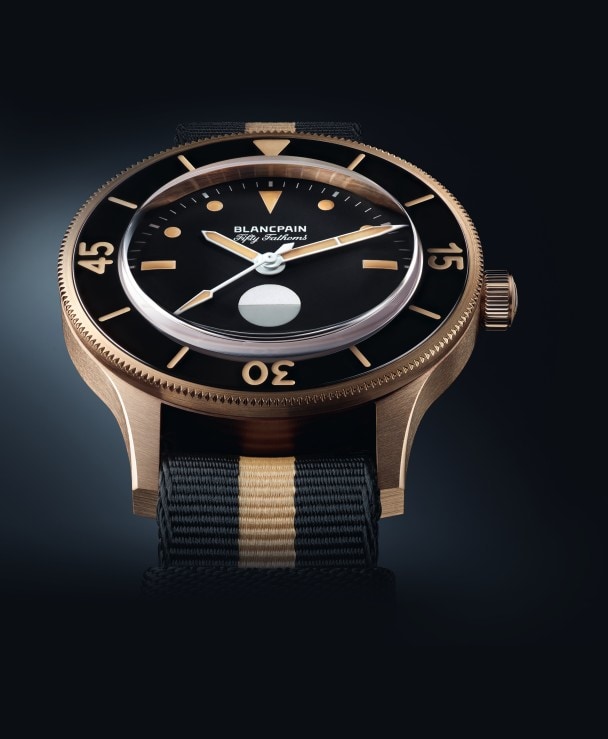
The new Blancpain Act 3.
The ACT 3 captures the feeling of the original and TRANSLATES it INTO A MODERN IDIOM.
The successor version of the MIL-SPEC was never sold as a civilian model; it was exclusively supplied to the US Navy. Moreover, the watches were never intended to become personal items for the divers who used them. Re-enforcing the restricted military use, each case back bore an inscription featuring the symbol for radioactivity and a warning: “DANGER IF FOUND RETURN TO THE NEAREST MILITARY FACILITY”. The intention of all of these policies was to prevent any examples of this MIL-SPEC from finding their way into civilian hands. Nonetheless, a handful did. Almost certainly, these few were “escapees” taken by either military or civilian contractor personnel when the MIL-SPEC was removed from service. With numbers so small, this version of the MIL-SPEC today lays claim to being the rarest of all the vintage Fifty Fathoms models. Surviving examples fetch stratospheric prices at auction.
The Fifty Fathoms 70th Anniversary Act 3, created by Blancpain as one of the trilogy of Fifty Fathoms Anniversary watches, was inspired by this history of the now iconic MIL-SPEC. Rather than being a mere recreation of the 1950s version, the Act 3 captures the feeling of the original and translates it into a modern idiom.
At first glance, the Act 3 broadcasts its links to the past. At once it is the color that announces itself. The German silver case of the original models has aged with time so as to acquire a bronze/rose hue. Today’s version captures a similar ambiance by using a material called “bronze gold”. Unlike pure bronze, which quickly oxidizes, giving over its warm tones to a greenish cast, bronze gold retains its color, as the name suggests, by the addition of gold, which blocks the oxidation. The addition of gold is significant enough to classify the alloy as nine carats. In common with its ancestor, the bronze-gold 41.3 mm case has a brushed finish.
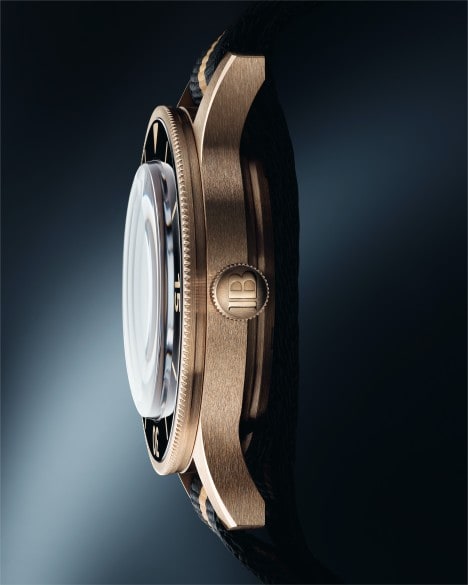
The hues of the bronze-gold Act 3 case and its brushed finish recall the distinguished finish of the vintage pieces.
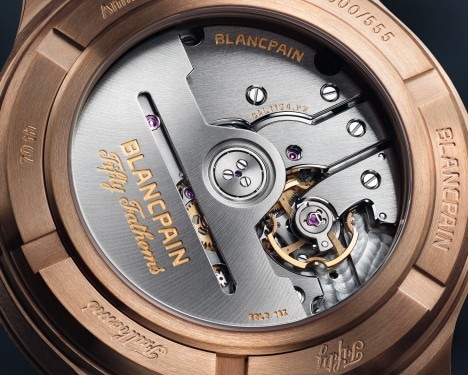
Act 3’s 1150 caliber twin-barrel movement, with its rhodium-plated gold winding rotor.
The dial likewise draws from the past. Prominent is the moisture indicator located at 6 o’clock, as was called out in the original 1955 Navy specification. So, too, following the 1955 specification, are the dial indexes: a triangle at 12; batons at 3, 6, and 9; and dots at the other five-minute positions. Adding drama to the dial is the sapphire crystal formed with raised sides. Termed a “glass box”, the raised sides allow additional light to illuminate the dial. The bezel tracks the specification with a flat surface (in contrast with the other members of the modern Fifty Fathoms models featuring a bombé sapphire bezel) and a triangle at 12, Arabic numerals at 15, 30 and 45, and stick markers at the other five-minute locations. Also recalling the vintage MIL-SPEC is the form of the bezel knurling with its narrow, smoothed teeth. Unlike the original, the bezel material is ceramic, offering scratch resistance far in excess of its ancestors. The hands, as well, follow the form of the original. The minute markers, bezel markings and hands are color-matched to the case.

VINTAGE DETAILS abound in the ACT 3 when placed side-by-side with a MIL-SPEC.
Closer examination reveals an unexpected detail: the Blancpain signature is done in an historic font. Today’s logo has the initial “B” and final “N” in a larger size than the other letters. As was done in the past, Act 3 spells the name in letters of equal size. There is a departure from the MIL-SPEC in that the words “Fifty Fathoms” are found on the dial. The watches supplied to the Navy had the words “U.S. NAVY” or “US” under the Blancpain signature. The font for the words “Fifty Fathoms” does, however, recall other vintage Fifties.
Carrying out the vintage color scheme, there is a center stripe on the nylon strap (recycled from fishing nets removed from the ocean, see the NATO strap article on pp. 84 of this issue) colored in a tone similar to that of the case and dial/bezel markings. This aesthetic can be compared to the G-10 straps in the updated British 66-47 specification, which introduced regimental stripes as an approved color (see pp. 91 of this issue).
Of course, the movement of Act 3 is the thoroughly modern in-house 1150, but in a special version. Depending on the timepiece, the 1150 caliber is produced by Blancpain in three aesthetically distinct styles. The variety fitted to the Act 3 is called “pont plat” (flat bridge). The upper bridges, with their refined brushed upper surfaces and polished anglage edges, have been widened to extend out over the full diameter of the mainplate. In common with all 1150 varieties, the Act 3 is fitted with two mainspring barrels that allow the watch to achieve a 100-hour power reserve. Its combination of a non-magnetic silicon hairspring and the proprietary alloys used in the escapement offers superior magnetic resistance of 1,000 gauss (“milgauss”), while at the same time allowing for a clear sapphire crystal case back. As with all Blancpain movements, the balance is free sprung with gold inertial regulation screws.
The Act 3 is supplied with something that was never part of the military sales: a box inspired by camera boxes used in the past for underwater photography.
Only 555 examples for the entire world will be made.
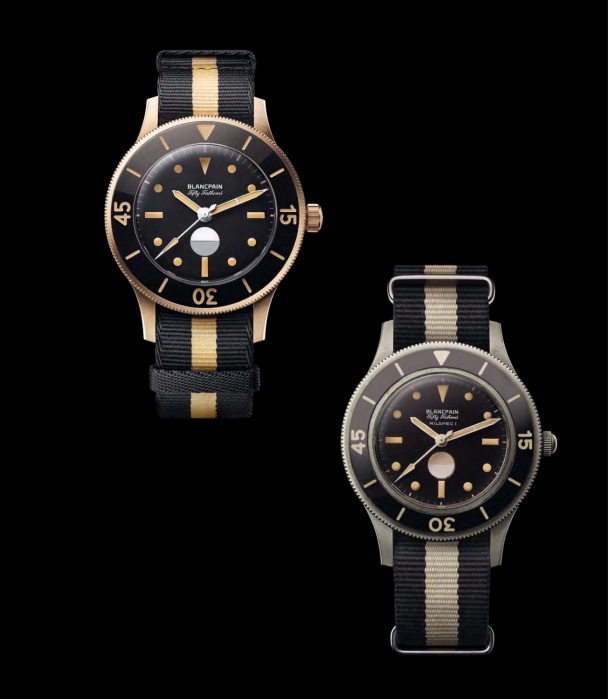
The original version of the MIL-SPEC on the right and today’s Act 3 on the left.
“Nobody could have foretold young peoples’ interest in the diving watch. And as for me, I am very happy to have played a part in the prelude.”
JEAN-JACQUES FIECHTER
Blancpain Co-CEO, 1950-1980

“[The Fifty Fathoms] is more than just a watch. It started out as a dive instrument. It is today again more than just a watch...with the Ocean Commitment bringing the ocean as a bigger theme, going beyond just an instrument or just a watch. And I am very happy that this is repeating itself like it was in the ‘50s. And as long as it might continue and work, and as long as I am here, I will continue to push it and develop it and cherish it.”
MARC A. HAYEK
Blancpain CEO and President, 2000-present
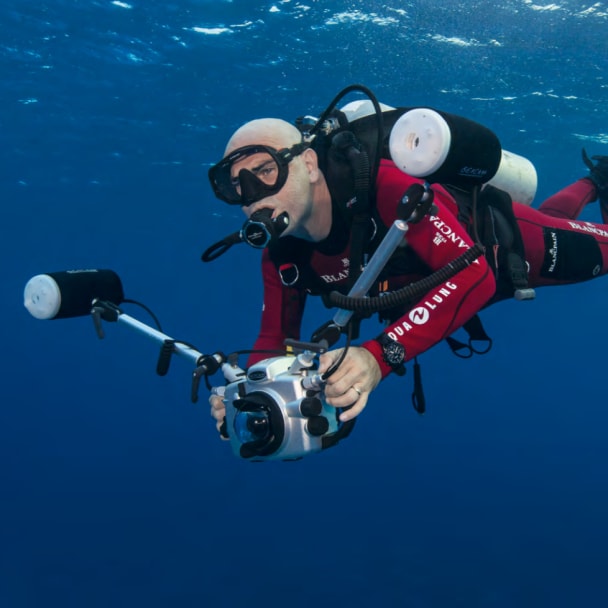
Other issues
Don't miss the latest issue
Sign Up for New Releases


